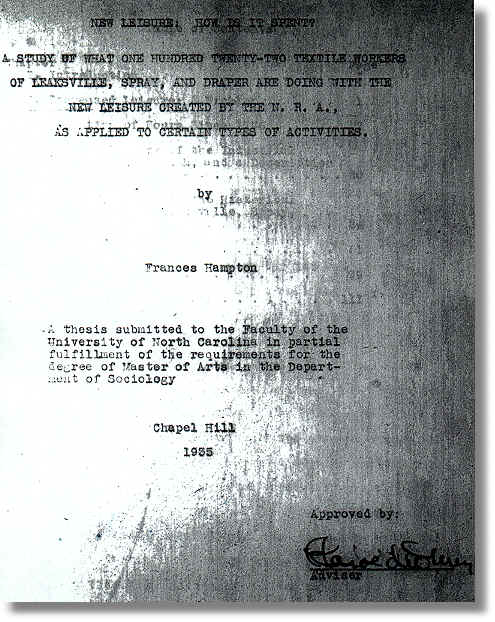A 1934 study, New Leisure, revealed how enthusiastically mill workers embraced the pleasures introduced in the 1920s. Sociologist Frances Hampton interviewed 122 workers in Leaksville, Spray, and Draper--a mill complex thirty miles northwest of Burlington, North Carolina. Her study showed how much times had changed since the days James Pharis (of Spray) remembered, when the only thing to do in summertime was to go to the mineral spring.
"The road would get thick with people going to the spring, trying to spend a bigger part of their Sundays with nothing to do but just drink water and talk." 1
Now, on soft summer evenings, millhands moved inside to listen to the radio or walked to the theater to see a movie. Eighty-seven of Hampton's 122 informants had radios in their homes, and, with the exception of some housewives who listened while they worked, most people gave broadcasts their undivided attention. Stringband music and jazz were their favorite programs. Although half of those interviewed owned Victrolas, most considered them "out of date" compared to a radio. One family found the radio so alluring that they sold their piano in order to purchase one.
Excerpts from Like a Family: The Making of a Southern Cotton Mill World, by Jacquelyn Dowd Hall, et al. (Chapel Hill, University of North Carolina Press, 1987).
NANNIE PHARIS remembered that in 1905 a labor agent persuaded her father to give up farming and to bring his 10 children with him to the new mill in Spray, North Carolina:
"[The agents] would come to our home, because there was so many of us. They needed help, hands in the mill. That's how we started. They got our father to move into town and we all went to work."
DAVE McCARNS wrote a poem about it:
"Lots of people with a good free will
Sold their homes and moved to the mill.
We'll have lots of money they said,
But every one got hell instead.
It was fun in the mountains rolling logs,
But now when the whistle blows we run like dogs."
1 Hampton, "New Leisure", and James Pharis interview, p.7. Hampton's sample of 122 workers included members of ninety families. For purposes of analysis she divided her sample by age and gender: the oldest group, age 40 and over (in 1935), consisted of 23 men and 14 women; the age group in the middle, 26 to 39 years old, had 27 men and 28 women; and the youngest group, 16 through 25 years of age, had only 3 men and 27 women.
Title :
New leisure : how is it spent / by Frances Hampton.
Author :
Publisher :
1935.
Description :
1 v. ; 29 cm.
Notes :
Thesis (M.A.)--University of North Carolina at Chapel Hill, 1935.
Includes bibliography.
OCLC No. :
39667551
Location
Call Number
Status
Davis Thesis
378.756 Sociol. H232n
c.1 /
Found in :
